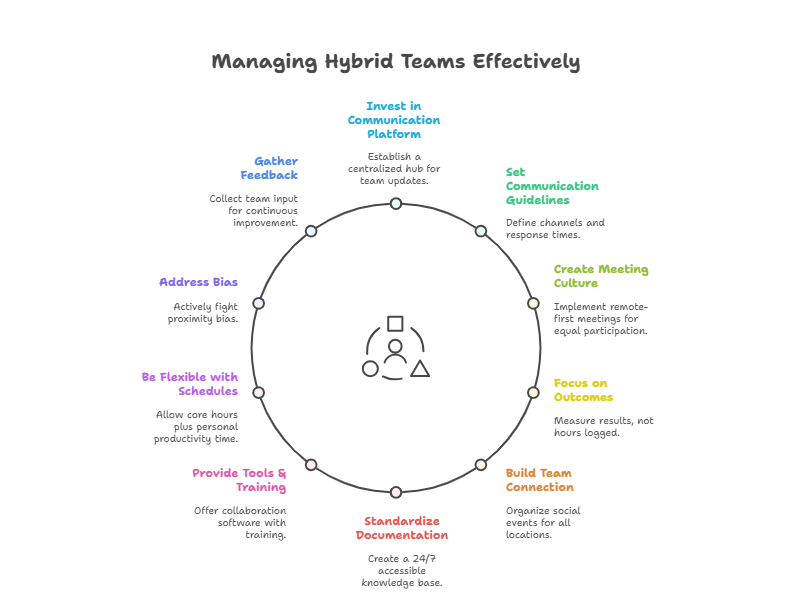
Remember when “going to work” meant everyone showed up at the same office at the same time? Yeah, those days are pretty much over. Today’s workplace looks different—some team members are grabbing coffee in the office kitchen while others are brewing their own at home. Welcome to the hybrid workplace model, where managing hybrid teams has become the new normal.
If you’re leading a hybrid team, you’ve probably experienced the unique challenges that come with it. How do you keep everyone on the same page when they’re not all in the same place? How do you build team culture across kitchen tables and conference rooms?
Don’t worry—you’re not alone in this. Let’s explore ten practical solutions that’ll help you manage your hybrid team like a pro.

10 Solutions for Managing Hybrid Teams
Here’s the thing about managing hybrid teams: communication can’t be an afterthought. When half your team is remote and the other half is in-office, those spontaneous desk-side chats don’t happen for everyone. That’s where a dedicated employee communication platform comes in.
Think beyond basic email and messaging apps. You need a centralized hub where everyone—regardless of location—can access important updates, company news, and team communications. This isn’t just about convenience; it’s about equality. Remote workers shouldn’t feel like they’re missing out on important information just because they’re not physically present.
Look for platforms that offer push notifications, content targeting, and analytics. This way, you’ll know your messages are actually being seen and read by your entire team. When everyone has equal access to information, you’re already halfway to successful hybrid team management.
Even with the best tools, managing hybrid teams falls apart without clear communication rules. Your team needs to know the “how, when, and where” of communication.
Start by defining which channels to use for what purpose. Maybe Slack is for quick questions, email is for formal communications, and your employee app is for company-wide announcements. Whatever you decide, make it crystal clear and document it.
Also, set expectations around response times. Should people respond to messages within an hour? By end of day? What about after hours? When your team knows the rules, there’s less frustration and fewer misunderstandings. This is especially crucial for hybrid teams where time zones and work schedules might vary.
Meetings in a hybrid workplace can be tricky. Ever been in a conference room with six people while three others are joining via video? Yeah, it usually doesn’t go well. The remote folks become second-class participants, struggling to hear and be heard.
Here’s a solution: adopt a “remote-first” meeting approach. Even if some people are in the office, have everyone join the video call from their own device. This levels the playing field and ensures everyone has an equal voice.
Also, be intentional about your meeting schedule. Avoid back-to-back video calls that exhaust remote workers, and make sure you’re not always scheduling meetings during hours that only work for in-office staff. Record important meetings for those who can’t attend live, and always share meeting notes afterward.
One of the biggest mistakes in managing hybrid teams is micromanaging based on hours logged or activity levels. Who cares if someone is “online” from 9 to 5 if they’re getting their work done?
Shift your focus to results and outcomes. Set clear goals, define what success looks like, and then trust your team to deliver. This approach works better for everyone—in-office and remote workers alike. It also prevents the toxic culture of “presenteeism” where people feel pressured to look busy rather than be productive.
Use project management tools to track progress on actual deliverables, not just hours worked. When you measure what matters, you’ll find that location becomes irrelevant.
Let’s be honest: remote workers can feel isolated. And in-office workers might feel like they’re carrying more of the social load. Managing hybrid teams means being deliberate about creating connections.
Schedule regular virtual coffee chats, team building activities, and social events that work for both remote and in-office employees. This might mean having virtual game sessions, online lunch-and-learns, or even sending care packages to remote team members.
Don’t forget about in-person gatherings too. Quarterly or annual all-hands meetings where everyone comes together can be powerful for building relationships and reinforcing company culture. The key is making sure these activities are inclusive and accessible to everyone, regardless of their work location.
In a hybrid workplace, “I’ll just swing by your desk” doesn’t work for half your team. That’s why documentation is critical for managing hybrid teams effectively.
Create a central knowledge base where processes, policies, and important information are documented and easily accessible. This could be a wiki, a shared drive, or a dedicated section in your employee communication platform. The goal is to make information available to everyone, 24/7.
Encourage your team to document their work, decisions, and learnings. When knowledge is shared openly, it reduces dependencies on specific people and ensures that remote workers aren’t left out of the loop. This also helps with onboarding new team members, whether they’re remote or in-office.
You can’t expect your hybrid team to succeed without proper tools. And no, we’re not just talking about laptops and Wi-Fi. Managing hybrid teams requires a thoughtful technology stack that supports collaboration, productivity, and communication.
Make sure everyone has access to:
But here’s the catch: don’t just throw technology at the problem. Provide training on how to use these tools effectively. The fanciest software in the world won’t help if your team doesn’t know how to use it or worse, if they’re overwhelmed by too many platforms.
One of the biggest advantages of the hybrid workplace model is flexibility. Don’t waste it by insisting everyone work rigid 9-to-5 schedules.
Different people have different peak productivity hours. Some team members might be morning people, while others do their best work in the evening. As long as there’s adequate overlap for collaboration and meetings, give your team the freedom to work when they work best.
This flexibility is especially important for managing hybrid teams across different time zones or for employees balancing childcare and other responsibilities. Set core collaboration hours when everyone should be available, and let team members manage the rest of their schedule themselves.
Here’s an uncomfortable truth: proximity bias is real. When managers are in the office, they naturally interact more with in-office employees. This can lead to remote workers being overlooked for promotions, interesting projects, or professional development opportunities.
Managing hybrid teams means actively fighting this bias. Make sure you’re distributing opportunities fairly across remote and in-office workers. Check in regularly with remote team members, not just those you see every day. Include remote workers in informal conversations and decision-making processes.
Also, be transparent about how performance is evaluated and how career advancement works. When everyone knows the criteria and sees that it’s applied fairly, trust builds and engagement increases.
No matter how well you plan, managing hybrid teams is an evolving challenge. What works today might not work six months from now. That’s why regular feedback is essential.
Create multiple channels for your team to share their experiences and concerns. This could be through regular pulse surveys, one-on-one check-ins, or anonymous feedback forms. Ask specific questions about communication, collaboration, workload, and work-life balance.
But here’s the most important part: actually act on the feedback you receive. When your team sees that their input leads to real changes, they’ll keep sharing honestly. This continuous improvement approach will help you refine your hybrid team management strategies over time.
Managing hybrid teams isn’t about finding a perfect formula—it’s about creating a system that works for your unique team and organization. The solutions we’ve covered here aren’t one-size-fits-all, but they provide a solid foundation for building a thriving hybrid workplace.
The key is to stay flexible, communicate openly, and prioritize both productivity and human connection. When you invest in the right tools—like a comprehensive employee communication platform—and combine them with thoughtful policies and practices, you create an environment where everyone can succeed, regardless of where they’re working from.
Remember, the goal isn’t to make remote work feel like office work or vice versa. It’s to create a new way of working that takes the best of both worlds and builds something even better. Your hybrid team has unique strengths that traditional offices never had: flexibility, diverse perspectives from different work environments, and the ability to tap into talent regardless of geography.
So embrace the complexity, experiment with what works, and keep your team at the center of every decision. The hybrid workplace model isn’t just the future—it’s the present. And with these solutions in your toolkit, you’re ready to lead your hybrid team to success.
Ready to transform your hybrid team communication? Discover how theEMPLOYEEapp can help you manage your hybrid workforce more effectively with centralized communications, targeted messaging, and powerful analytics. Learn more at www.theemployeeapp.com.